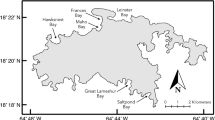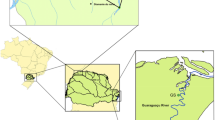Abstract
We report on the habitat dependent invasion and control pattern of the English cordgrass, Spartina anglica C. E. Hubbard, in Puget Sound, Washington. In 36 years, the plant has successfully invaded 73 sites, affecting 3311 ha of marine intertidal habitat, which if allowed to solidly fill, would equal ∼ 400 ha. Invasion and control both depend on habitat type. Mudflats and low salinity marshes have significantly more solid area of S. anglica than do high salinity marshes and cobble beaches. Control efforts since 1997 have resulted in a 13% decline of the grass. We find that high salinity marshes have the greatest decline (∼ 70%), low salinity marshes have the lowest decline (∼ 10%), and mudflat (∼ 29%) and cobble beaches (∼ 21%) have intermediate losses. We hypothesize that invasion success and control are dependent on a relatively complex interplay between habitat physical conditions and species interactions.
Similar content being viewed by others
References
Aberle BL (1993) The biology and control of introduced Spartina (Cordgrass) worldwide and recommendations for its control in Washington. MS Thesis, The Evergreen State College, Olympia, Washington, 176 pp
Bruno J (2000) Facilitation of cobble beach plant communities through habitat modification by Spartina alterniflora. Ecology 81: 1179-1192
Bruno J and Kennedy CW (2000) Reduction of wave-related disturbance in cobble beach habitats by Spartina alterniflora: importance of bed size. Oecologia 122: 98-108
Callaway JC and Josselyn MN (1992) The introduction and spread of smooth cordgrass (Spartina alterniflora) in South San Francisco Bay. Estuaries 15: 218-226
Daehler CC and Strong DR (1996) Status, prediction and prevention of introduced cordgrass, Spartina spp. invasions in Pacific estuaries, USA. Biological Conservation 78: 51-58
Dethier MN (1990) A marine and estuarine habitat classification system forWashington state. Washington Natural Heritage Program, Department of Natural Resources, Olympia, Washington, 56 pp
Ferris C, King RA and Gray AJ (1997) Molecular evidence for the maternal parentage in the hybrid origin of Spartina anglica C. E. Hubbard. Molecular Ecology 6: 185-187
Frenkel RF (1987) Introduction and spread of cordgrass Spartina into the Pacific Northwest. Northwest Environmental Journal 3: 152-154
Goss-Custard JD and Moser ME (1988) Rates of change in the numbers of Dunlin, Calidris alpina, wintering in British estuaries in relation to the spread of Spartina anglica. Journal of Applied Ecology 25: 95-109
Gray AJ, Marshall DF and Raybould AF (1991) A century of evolution in Spartina anglica. Advances in Ecological Research 21: 1-62
Hedge P and Kriwoken LK (2000) Evidence for effects of Spartina anglica invasion on benthic macrofauna in Little Swanport estuary, Tasmania. Austral Ecology 25: 150-159
Hubbard JCE and Stebbings RE (1968) Spartina marshes in southern England. VII. Stratigraphy of the Keyworth marsh, Poole Harbour. Journal of Ecology 56: 702-722
Huckle JM, Potter JA and Marrs RH (2000) Influence of environmental factors on the growth and interactions between salt marsh plants: effects of salinity, sediment and waterlogging. Journal of Ecology 88: 492-505
Jackson D, Mason CF and Long SP (1985) Macroinvertebrate populations and production on a salt marsh in east England dominated by Spartina anglica. Oecologia 65: 406-411
Lana P and Guiss C (1991) Influence of Spartina alterniflora on structure and temporal variability of macrobenthic associations in a tidal flat of Paranagua Bay, Brazil. Marine Ecology Progress Series 73: 231-244
Lee WG and Partridge TR (1983) Rates of spread of Spartina anglica and sediment accretion in the New River Estuary, Invercargill, New Zealand. New Zealand Journal of Botany 21: 231-236
Marchant CJ (1967) Evolution in Spartina (Gramineae). I. The history and morphology of the genus in Britain. Journal of the Linnean Society (Botany) 60: 1-24
Marchant CJ (1968) Evolution in Spartina (Gramineae). II. Chromosomes, basic relationships and the problem of S. × townsendii agg. Journal of the Linnean Society (Botany) 60: 381-409
Millard AV and Evans PR (1984) Colonization of mudflats by Spartina anglica: some effects on invertebrate and shorebird populations at Lindisfarne. In: Doody JP (ed) Spartina anglica in Great Britain, pp 41-48. Nature Conservancy Council, Attingham
Parker IM, Simberloff D, Lonsdale WM, Goodell K, Wonham W, Karieva PM, Williamson MH, Von Holle B, Moyle PB, Byers JE and Goldwasser L (1999) Impact: towards a framework for understanding the ecological effects of invaders. Biological Invasions 1: 3-19
Ranwell DS (1967) World resources of Spartina townsendii and economic use of Spartina marshlands. Journal of Applied Ecology 4: 239-256
Raybould AF, Gray AJ, Lawrence MJ and Marshall DF (1991) The evolution of Spartina anglica C. E. Hubbard (Gramineae): genetic variation and status of the parental species in Britain. Biological Journal of the Linnean Society 44: 369-380
Sayce K (1988) Introduced cordgrass Spartina alterniflora Loisel. in salt marshes and tidelands of Willapa Bay, Washington. Final report, United States Fish and Wildlife Service, USFWS FWSI-87058 TS, 70 pp
Scholten MCT and Rozema J (1990) The competitive ability of Spartina anglica on Dutch saltmarshes. In: Gray AJ and Benham PEM (eds) Spartina anglica-a Research Review, pp 39-47. HMSO, London
Thompson JD (1991) The biology of an invasive plant: What makes Spartina anglica so successful? BioScience 41: 393-401
Thompson JD, McNeilly T and Gray AJ (1993) The demography of clonal plants in relation to successional habitat change: the case of Spartina anglica. In: Miles J and Walton DWH (eds) Primary Succession on Land, pp 193-207. Blackwell Scientific Publications, Oxford
Author information
Authors and Affiliations
Corresponding author
Rights and permissions
About this article
Cite this article
Hacker, S.D., Heimer, D., Hellquist, C.E. et al. A Marine Plant (Spartina Anglica) Invades Widely Varying Habitats: Potential Mechanisms of Invasion and Control. Biological Invasions 3, 211–217 (2001). https://doi.org/10.1023/A:1014555516373
Issue Date:
DOI: https://doi.org/10.1023/A:1014555516373




